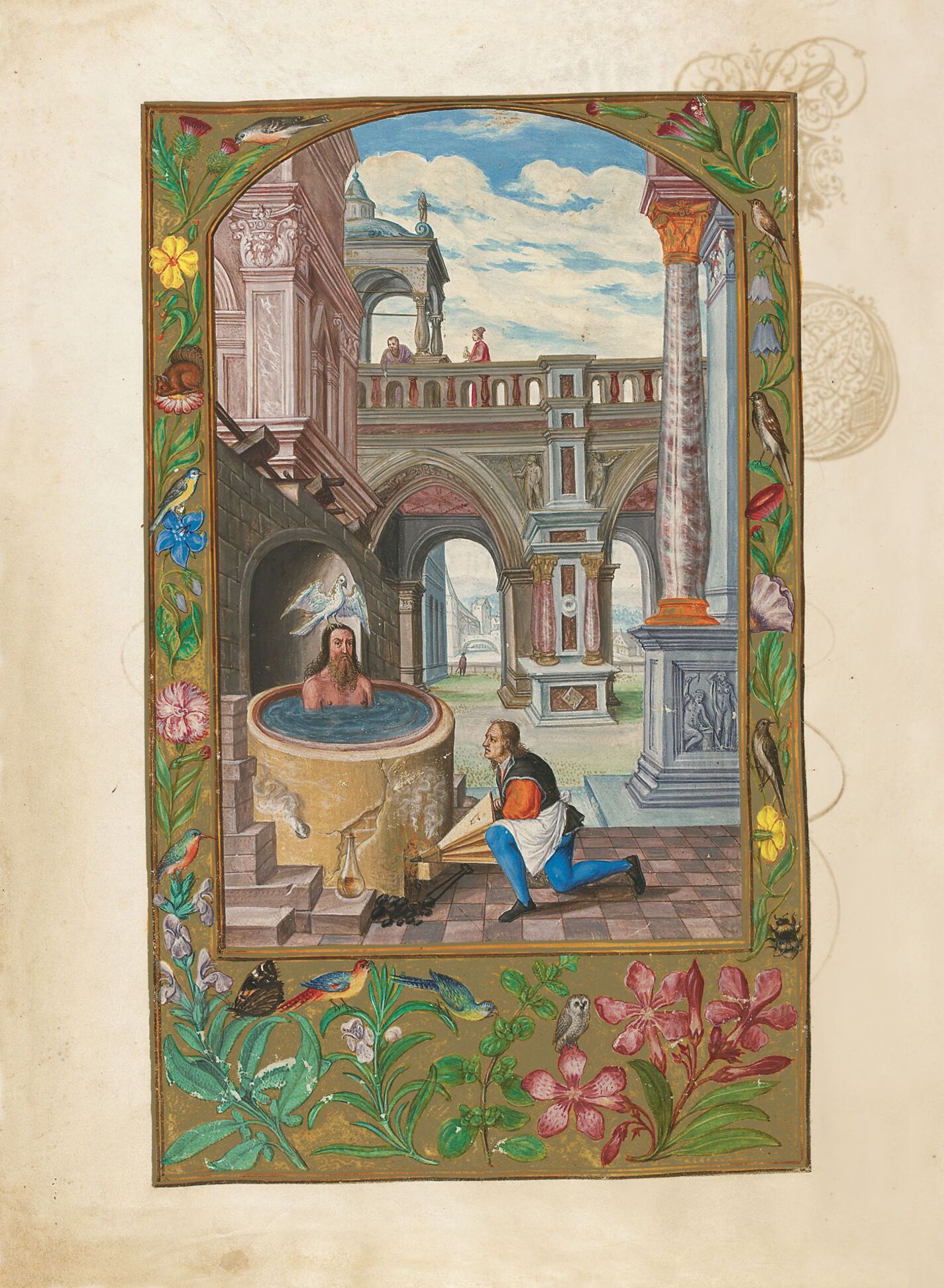The left foreground of the picture is occupied by a rendered brick oven with an inlaid copper-coloured tub. In this cauldron, which is filled to the brim with liquid, an elderly man is sitting up to his chest in water. Perched on top of the man’s head, notable for its long dark hair and beard, is a large white dove with shimmering gold plumage. With its wings raised, it seems ready to take flight. In front of the oven is a young man kneeling down on one knee. He pumps air into the fire with a hand bellows in a bid to keep the liquid at the right temperature. The young man's clothing – fine blue stockings and an orange-red doublet underneath a black, silver-braided vest and white apron – suggests that he is no mere servant charged with the task of stoking the fire. With his left elbow resting upon his knee, his gaze fastened on the old man, the young man is clearly watching for changes of state. The grand, Venetian-style fantasy architecture in the background embellishes the scene.
At this point in the Splendor Solis, mention is made of a tale by Ovid in which a wise old man, in a quest for rejuvenation, has himself cut to pieces and boiled. The process of boiling, or decoction, will, he believes, bring his limbs back together as part of a rejuvenated and stronger whole. Alchemy regards the decoction of matter as equivalent to the operation of putrefaction, insofar as it serves as a starting point for the perfection process. The dove perched on the head of the old man can be interpreted as an image of sublimation, as the fleeting distillate of the decoction process, which, following putrefaction, reunites with the physical residue in the flask. In his entry on the “Colombe”, Pernety confirms this association, pointing out that it is the task of the souffleur, in pumping the bellows, to ensure the success of the alchemical project.
This depiction of decoction was inspired by two miniatures from the Aurora Consurgens – the sage in the cauldron pertains to the fifteenth and the kneeling souffleur to the thirteenth illustration in the manuscript. By incorporating an image of the sculptor Pygmalion into the miniature, which is set into the tall base on the lower right, the painter added of his own accord a second episode from Ovid’s Metamorphoses. In so doing, he alluded to the creation of a new, ideal human being – a mythological theme that congenially concurs with the ideas of alchemy.
Jörg Völlnagel
(Art historian, research associate at the Staatliche Museen zu Berlin)

The left foreground of the picture is occupied by a rendered brick oven with an inlaid copper-coloured tub. In this cauldron, which is filled to the brim with liquid, an elderly man is sitting up to his chest in water. Perched on top of the man’s head, notable for its long dark hair and beard, is a large white dove with shimmering gold plumage. With its wings raised, it seems ready to take flight. In front of the oven is a young man kneeling down on one knee. He pumps air into the fire with a hand bellows in a bid to keep the liquid at the right temperature. The young man's clothing – fine blue stockings and an orange-red doublet underneath a black, silver-braided vest and white apron – suggests that he is no mere servant charged with the task of stoking the fire. With his left elbow resting upon his knee, his gaze fastened on the old man, the young man is clearly watching for changes of state. The grand, Venetian-style fantasy architecture in the background embellishes the scene.
At this point in the Splendor Solis, mention is made of a tale by Ovid in which a wise old man, in a quest for rejuvenation, has himself cut to pieces and boiled. The process of boiling, or decoction, will, he believes, bring his limbs back together as part of a rejuvenated and stronger whole. Alchemy regards the decoction of matter as equivalent to the operation of putrefaction, insofar as it serves as a starting point for the perfection process. The dove perched on the head of the old man can be interpreted as an image of sublimation, as the fleeting distillate of the decoction process, which, following putrefaction, reunites with the physical residue in the flask. In his entry on the “Colombe”, Pernety confirms this association, pointing out that it is the task of the souffleur, in pumping the bellows, to ensure the success of the alchemical project.
This depiction of decoction was inspired by two miniatures from the Aurora Consurgens – the sage in the cauldron pertains to the fifteenth and the kneeling souffleur to the thirteenth illustration in the manuscript. By incorporating an image of the sculptor Pygmalion into the miniature, which is set into the tall base on the lower right, the painter added of his own accord a second episode from Ovid’s Metamorphoses. In so doing, he alluded to the creation of a new, ideal human being – a mythological theme that congenially concurs with the ideas of alchemy.
Jörg Völlnagel
(Art historian, research associate at the Staatliche Museen zu Berlin)